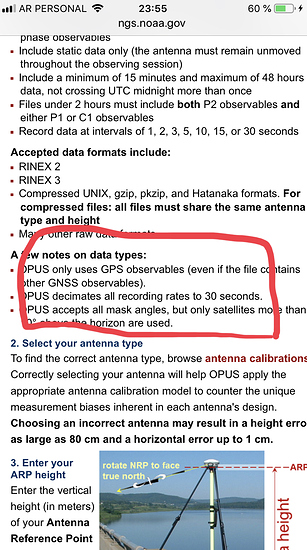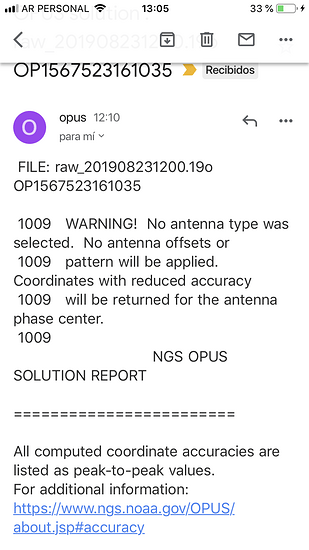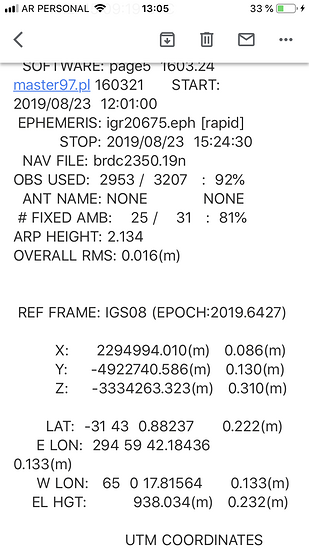Could you send me a screen shot of your RS2 logging settings. Maybe I am missing something because it keeps aborting mine saying. during base line analysis less than 3 reference stations etc.etc.
Thanks
Sorry no screen shot but being serious how long are you waiting between the time you finish the observations and the time you submit to opus? OPUS is a strange creature sometimes the error messages really do point to the problem while for no reason other times it uses messages that are not correct. Then a week later you submit it and it goes right through no errors. Opus seems to try to find errors in the first few lines though just to kick the upload and save CPU and bandwidth for the servers. Off the top of my head choose rinex 2.1, then only record gps and glonss, and make it 1 second. That right there is all then let a few days go by or else you will get corrections from really far away stations as they where the only ones that had data to be used because you did it to quickly.
Hi Jeff,
Have you changed the Update rate in ReachView RTK Settings to 1 Hz?
Have you already tried converting to RINEX 2.11 in RTKConv?
Hi Bryce,
May I ask you to post the Simple System report from your device here so we can check your configurations?
Tatiana yes did both of those
Brycethomaskennedy,
You were absolutly correct. In the past which was a good eight years ago I would send off the Rinex files as soon as I returned from the field and never had an Issue but under your advice I pulled out some data from the previous week and sent it and bang got a solution returned. I had six different test files over the last week and they all processed with no Issues. Thanks for the Info was really getting frustrated over nothing.
Jeff
Only GPS for OPUS Not gnss. See page NGS
Jeff
so were you successful with getting RS2 to work with OPUS and if so have you compared your results to a previous OPUS’d location?
I have perfectly processed rinex RS2 files by OPUS, I only did the rinex with gps and unfortunately the antenna is not registered in NGS
Tracy,
Yes I was both using the .ubx conversion to rinex and the straight rinex my issue was evidently not waiting a day to send it out. I have not yet had time to do some accuracy verification as of yet will be checking it here in the next few weeks.
Jeff
Ok, thanks to advice from “brycethomaskennedy”, I now have gotten one file to a solution from OPUS. It was over a NGS survey mark. It was a 16 minute observation. The RTK averaged values over the mark fell 0.0143 meters (14 millimeters) from the NGS datasheet values. (Both NAD83, 2011). The OPUS returned values from a portion of the same observations returned a fix that falls 0.108 meters from the data sheet values. Very interesting.
Is it in others experience that only Rinex 2.11 files will reach an OPUS solution?
I tried to send a log to the Canadian PPP service (similar to ops) but it also automatically flagged the file as Single frequency.
The results were not great so will have to try again. The first rinex log was directly on the device.
If the rinex file is very recent you will not get good results, you should wait at least one week. Remember to rename the .obs files for .19o. I would have to see if it accepts gnss files
im not sure what your talking about there, is that a NTRIP correction source for the RTK?
that sounds about right for 16min of OPUS rapid static, i have two CHC OPUS receivers and reliable 2cm accuracy requires +2 hours of data.
i have done about 50 OPUS observations and actually i don’t find waiting for precise orbits makes much of a difference. maybe it does for < 2hour rapid static but its been awhile since i tried that.
Yes, it was Base station service from Vermont Vector, via online NTRIP…
On the OPUS website it asks for Antenna Type and has a lot of options in the pulldown. Is there a recommended selection for the RS2? It appears in your screenshot that no antenna type was selected.
The RS2 antenna is not available in the IGS database, we expect EMLID to make the antenna data available. In OPUS the data of the GNSS antennas is very important. A patient man knows how to wait hi







